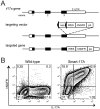Marking and quantifying IL-17A-producing cells in vivo
- PMID: 22768117
- PMCID: PMC3387253
- DOI: 10.1371/journal.pone.0039750
Marking and quantifying IL-17A-producing cells in vivo
Abstract
Interleukin (IL)-17A plays an important role in host defense against a variety of pathogens and may also contribute to the pathogenesis of autoimmune diseases. However, precise identification and quantification of the cells that produce this cytokine in vivo have not been performed. We generated novel IL-17A reporter mice to investigate expression of IL-17A during Klebsiella pneumoniae infection and during experimental autoimmune encephalomyelitis, conditions previously demonstrated to potently induce IL-17A production. In both settings, the majority of IL-17A was produced by non-CD4(+) T cells, particularly γδ T cells, but also invariant NKT cells and other CD4(-)CD3ε(+) cells. As measured in dual-reporter mice, IFN-γ-producing Th1 cells greatly outnumbered IL-17A-producing Th17 cells throughout both challenges. Production of IL-17A by cells from unchallenged mice or by non-T cells under any condition was not evident. Administration of IL-1β and/or IL-23 elicited rapid production of IL-17A by γδ T cells, invariant NKT cells and other CD4(-)CD3ε(+) cells in vivo, demonstrating that these cells are poised for rapid cytokine production and likely comprise the major sources of this cytokine during acute immunologic challenges.
Conflict of interest statement
Figures






References
-
- Iwakura Y, Nakae S, Saijo S, Ishigame H. The roles of IL-17A in inflammatory immune responses and host defense against pathogens. Immunol Rev. 2008;226:57–79. - PubMed
-
- Martin B, Hirota K, Cua DJ, Stockinger B, Veldhoen M. Interleukin-17-producing gammadelta T cells selectively expand in response to pathogen products and environmental signals. Immunity. 2009;31:321–330. - PubMed
Publication types
MeSH terms
Substances
Grants and funding
LinkOut - more resources
Full Text Sources
Molecular Biology Databases
Research Materials

